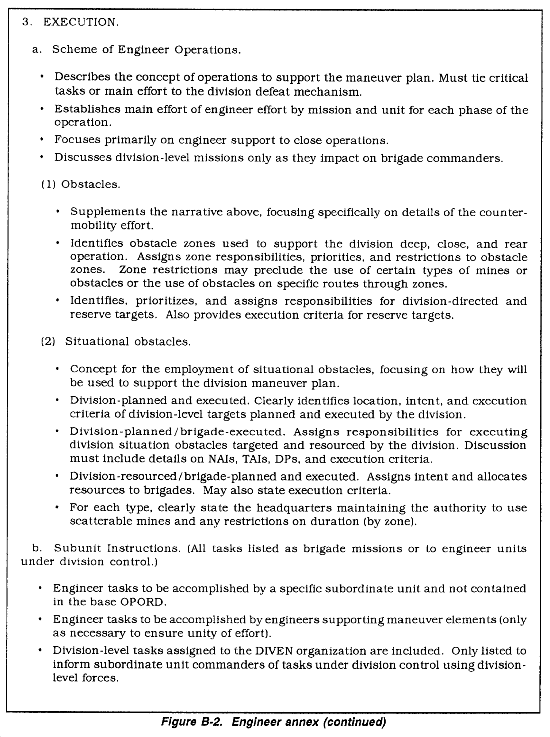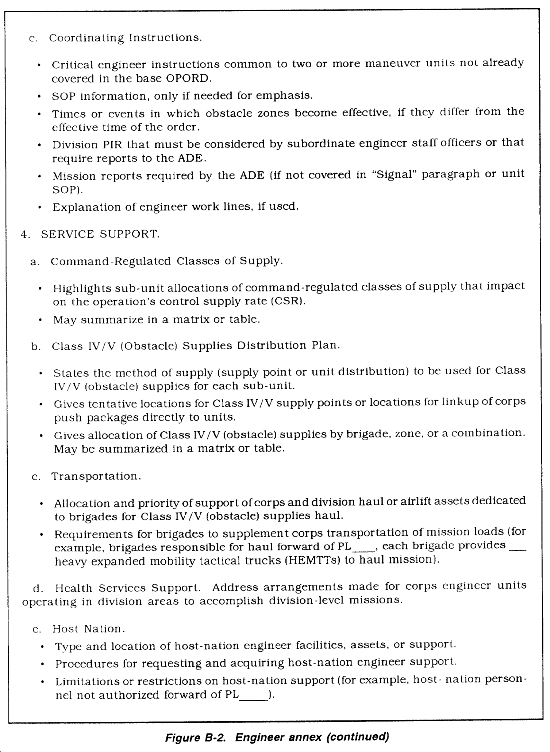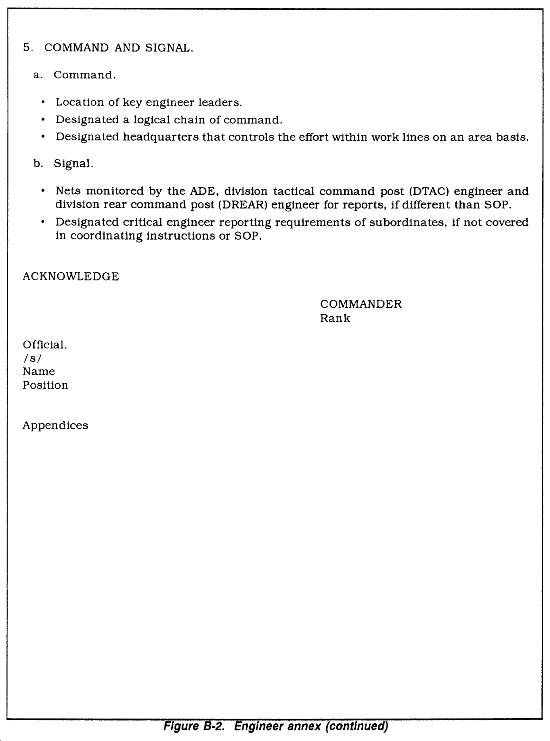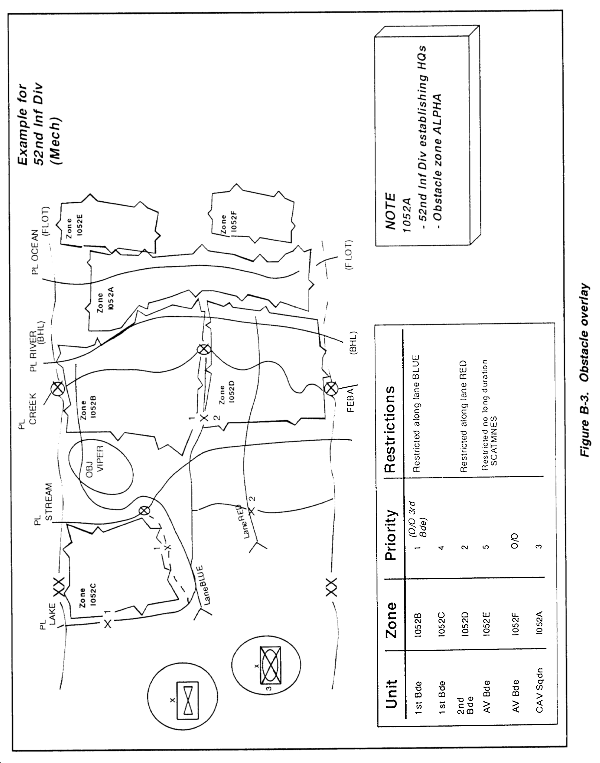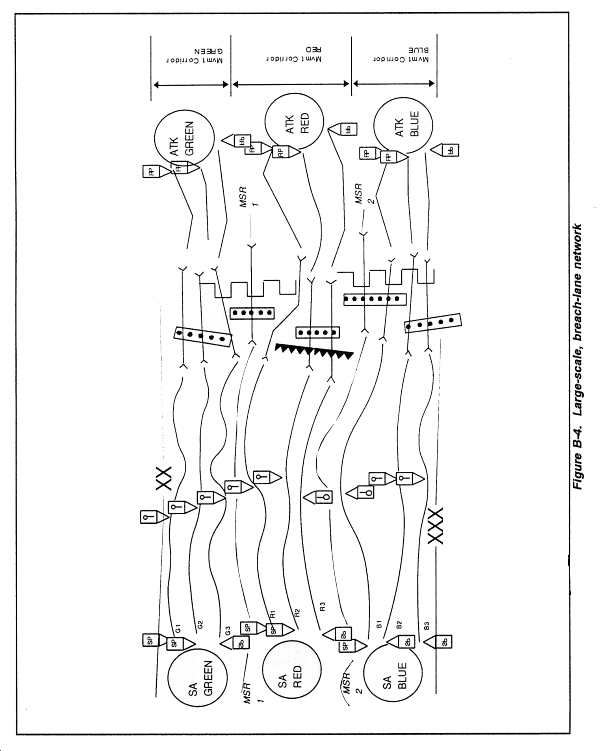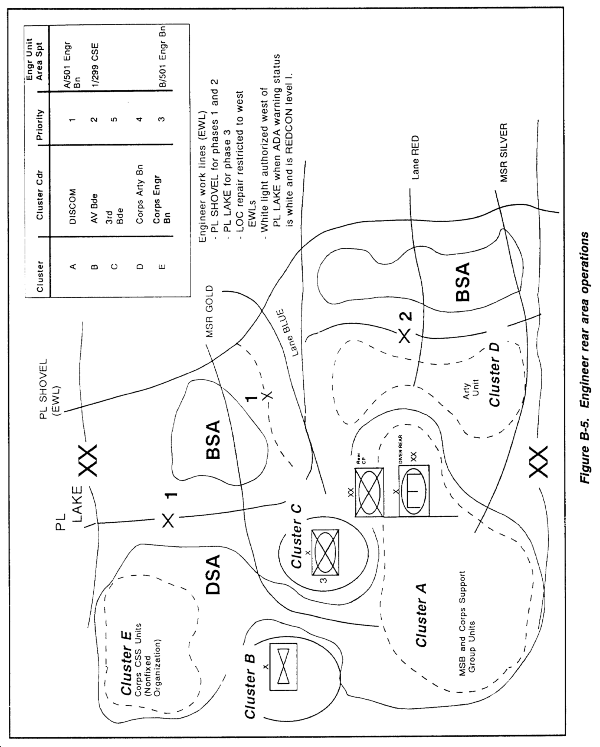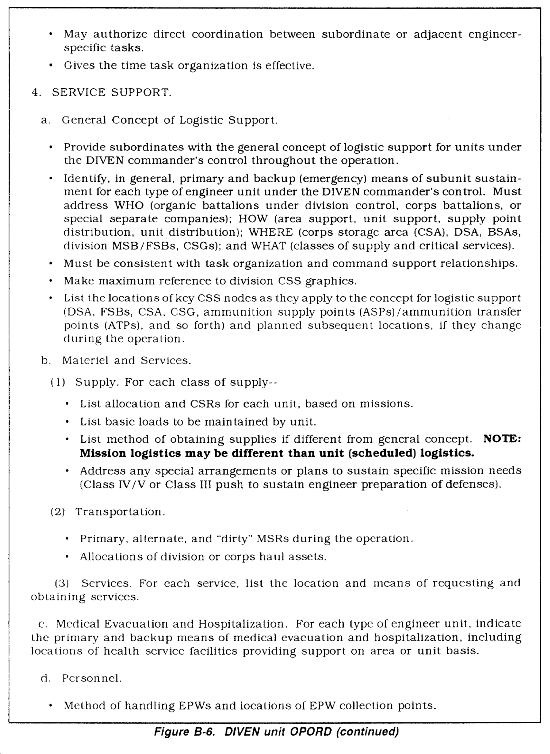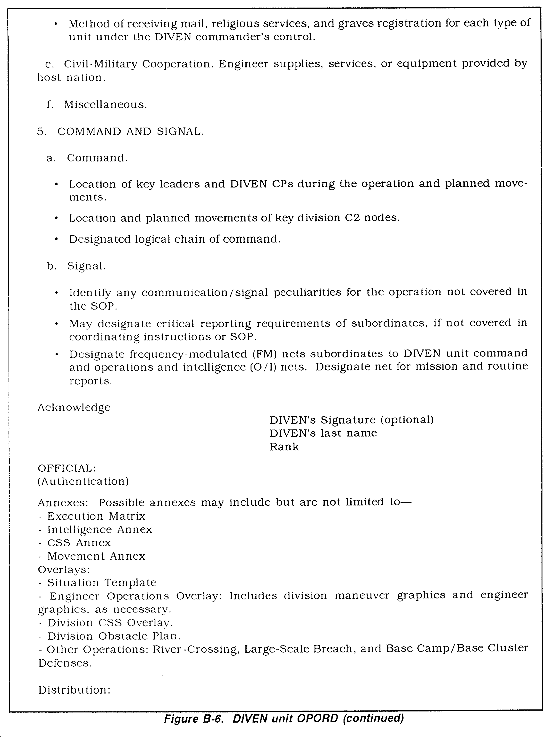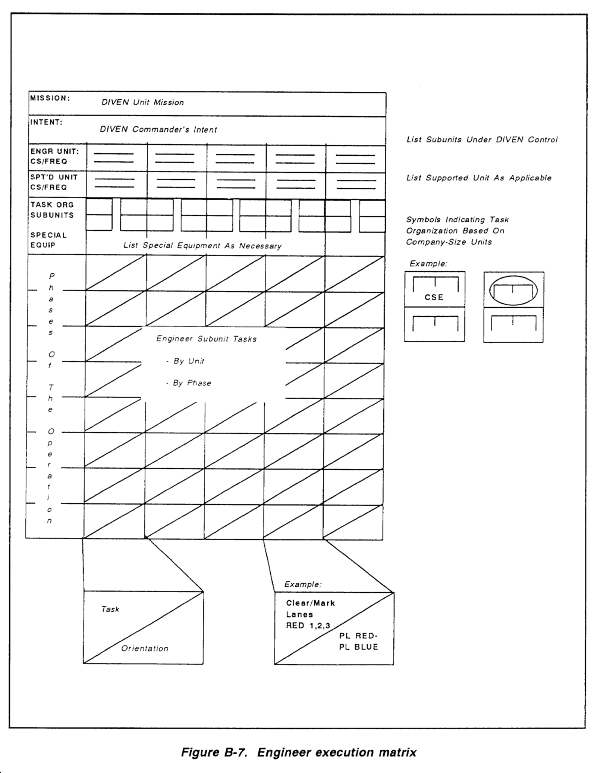APPENDIX B
ORDERS AND ANNEXES
Orders and annexes are critical components of DIVEN C2. The DIVEN commander exercises functional control over engineer operations within the division (engineer units supporting maneuver brigades) by including critical instructions in the division order and the engineer annex. The DIVEN commander also issues a unit order to exercise both functional and unit control over forces committed to division-level operations (corps engineer units under the DIVEN commander's control). These units are normally task organized by the division under the control of the DIVEN commander. Therefore, it is imperative that the DIVEN commander understands how to use the combination of division and unit orders to convey the plan.
This appendix is divided into two major sections. The first section deals with the division OPORD and the engineer annex. This section provides the base format of the division OPORD, highlighting areas where the DIVEN commander may have direct input. It also outlines the format and content of the engineer annex as well as provides sample overlays. The second section focuses on DIVEN unit orders. It provides a format and content for the DIVEN unit WARNORD and OPORD, including possible annexes, overlays, and FRAGOs.
Division Orders and Engineer Annex
Division OPORD. Figure B-1, is a sample format of the division OPORD. Paragraphs in which the DIVEN commander may provide engineer input are highlighted.
Engineer Annex. The engineer annex contains information not included in the base division order that is critical to the division engineer plan or required for subordinate engineer planning. It does not include instructions or orders directly to engineer units. All instructions or tasks are addressed to maneuver brigades, not supporting engineer units. More importantly, the engineer annex covers critical aspects of the entire engineer plan, not just parts that pertain to engineer units. The engineer annex is not a replacement for a unit order. For example, it does not give subunit orders and service support instructions to engineer units remaining under the DIVEN command; those orders and instructions are contained in the DIVEN unit order. The engineer annex should meet the following general criteria:
- Includes critical information derived from the EBA process.
- Contains all critical information and tasks not covered elsewhere in the order.
- Does not contain items covered in SOPs, unless the mission requires a change to the SOP.
- Contains information and tasks directed to major subordinate elements of the division, not supporting engineer units.
- Is clear, complete, brief, and timely and avoids qualified directives.
- Includes only information and instructions that have been fully coordinated with other parts of the OPORD, division commander, and staff.
The engineer annex includes any combination of written instructions, matrices, or overlays necessary to convey the necessary details of the engineer plan. The engineer annex outlined below provides a standard format for both offensive and defensive operations. This format standardizes the organization of information included as written instructions. The actual content depends on the type of operation and engineer plan. A standardized annex format makes it easier for the engineer staff officer to remember what should be included as well as for subordinate staff officers to find required information. The format tailors the five-paragraph order to convey critical information.
The engineer annex may also include matrices and overlays, as necessary, to convey the plan. Matrices may be used as part of the body of the annex or as separate appendices. Matrices are used to quickly convey or summarize information not needing explanation, such as logistic allocations, obstacle zone priorities and restrictions, or task summary (execution matrix). Finally, overlays are used to give information or instructions and expedite integration into the overall combined arms plan. At division level, information included on overlays may include but is not limited to--
- All existing and proposed friendly obstacles and control measures (obstacle zones, restrictions, and lanes; directed or reserve targets; and division-level situational obstacles, including associated NAI/TAI).
- Known and plotted enemy obstacles (must also be on situation template).
- Logistic locations and routes, as they apply to engineer operations.
- NBC-contaminated areas.
Figure B-2, is a sample format of a written engineer annex. Figures B-3 through B-5, provide sample matrices and overlays.
Engineer Unit Orders
The DIVEN commander uses a unit order to exercise unit control over engineer units remaining under his command. At the outset of an operation, the DIVEN commander uses his order to effect the necessary task organization of engineers in the division, assign initial missions, and establish sustainment integration with the FSB, MSB, and corps support group (CSG). Once the task organization is effective and during combat operations, the DIVEN commander directs subsequent unit orders only to those engineers under his command. Orders missions, and instructions to engineers supporting maneuver brigades in command relationships are included as tasks to the brigades in the division order. The exception is the DIVEN unit WARNORD. The DIVEN commander issues WARNORDs to all engineers in the division to facilitate parallel planning within engineer units and brigade-level engineer staffs. WARNORDs to engineers supporting maneuver brigades are for planning only and are not executive.
DIVEN Unit WARNORD. The purpose of the WARNORD is to help engineer staff officers and engineer units initiate planning and preparations for an upcoming operation. The WARNORD is critical to foster parallel planning at the engineer unit and maneuver brigade levels.
There is no prescribed format for the WARNORD. It may be either written or oral but should include the following information:
Heading: WARNORDs must always begin with the words "Warning Order" to ensure recipients understand the information is for use only as a basis for planning and will be followed by orders. The addressees should also be listed in the heading. The DIVEN unit WARNORD should address all engineer units in the division.
Situation: This section includes a brief description of friendly and enemy situations and critical events. It may also include probable missions for the division and specified or implied tasks, and it may assign tentative tasks for planning only to engineer units.
Attachments/detachments: This section gives tentative and known changes to the task organization. However, it must be clear to engineers supporting maneuver brigades that changes in task organization are for planning and will not be effective until after an order is received from division by the supported brigade.
Earliest time of move: This section states the earliest possible time that units must be ready to move. For units under the DIVEN commander's command, actual movement times may be given, if known. The earliest time of move is critical to synchronizing sustainment operations to support future missions.
Nature and time of the operation: This section provides recipients with as much information about the division plan as possible to foster parallel planning and preparations and to set priorities. Depending on the maturity of the planning process, this section may include a concept of engineer operations or tentative scheme-of-engineer operations. Orders for preliminary action may also be included, assigning engineer tasks such as tactical/technical reconnaissance, establishing Class IV/V supplies (mine points for), and moving to linkup points. These orders are normally qualified as be prepared or on order tasks, depending on how the plan is established. Orders to engineers supporting maneuver brigades are always "on order" with execution instructions coming through maneuver headquarters-generated orders.
Time and place of orders group: Units under the DIVEN commander's command are told when and where to receive the entire order and who will attend. Units should identify the composition of the orders group in their SOP.
Administrative/logistical information: This includes instructions and warning information on changes in unit logistics operations and lash-up with maneuver sustainment systems as required by future operations. This information may also direct movement to assembly areas and provide instructions for sustainment after movement.
Acknowledgement: An acknowledgement of receipt is always required to make sure it is received by all addressees.
DIVEN Unit OPORD. The DIVEN commander issues OPORDs to all engineer units under his command. The DIVEN commander's OPORD may initially include any engineer unit operating in the division area as necessary to effect the task organization, assign missions, and establish sustainment responsibility at the outset of an operation. However, once the task organization is effected, all instructions and missions to engineers supporting maneuver brigades are conveyed in division orders and are addressed to the maneuver brigade commanders. The following is an outline of the content of DIVEN unit OPORDs using the standard five-paragraph field order (Figures B-6 and B-7). When the order is an OPLAN instead of an OPORD, assumptions on which the plan is based are included at the end of the "Situation" paragraph.
DIVEN Unit FRAGO. The DIVEN commander will frequently need to modify his OPORD through the use of FRAGOs to make changes in engineer operations that allow the division to take advantage of tactical opportunities. The DIVEN commander issues FRAGOs only to engineer units under his command. Changes in instructions to engineers supporting maneuver brigades in command relationships are conveyed through input into the division FRAGO. A FRAGO does not have a specified format, but an abbreviated OPORD format is usually used. The key to issuing a FRAGO is to maximize the use of the current OPORD by specifying only information and instructions that have changed. The DIVEN commander can rarely issue FRAGOs to his subordinate commanders face-to-face. He must normally issue FRAGOs over the radio. The DIVEN commander may use the XO or a member of his staff to issue the FRAGO in person to subordinate engineer commanders. This ensures that commanders understand the FRAGO and allows graphics to be provided. A FRAGO usually contains the following elements:
Changes to task organization: Any changes to unit task organizations made necessary by the modification to the order.
Situation: Includes a brief statement of current enemy and friendly situations which usually gives the reason for the FRAGO. It may also update subordinates on the current status of division-level engineer missions.
Concept: Gives changes to the scheme of engineer operations and the corresponding changes to subunit tasks. Must also include any changes in the division or DIVEN commander's intent.
Coordinating instructions: Includes changes to Service Support and Command and Signal paragraphs of the current OPORD made necessary by the change in scheme of engineer operations.
|
NEWSLETTER
|
| Join the GlobalSecurity.org mailing list |
|
|
|






